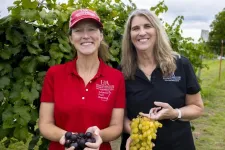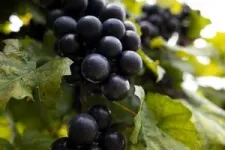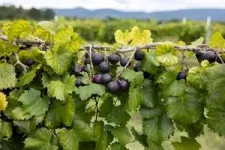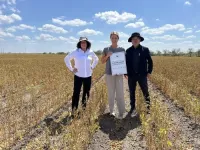(Press-News.org) By John Lovett
Arkansas Agricultural Experiment Station
FAYETTEVILLE, Ark. — Muscadines may be the folksy American of the grape world, but they have many qualities like disease resistance and unique flavors that are desired in the more popular Vitis vinifera (bunch grapes) species.
Likewise, Vitis vinifera — the species that most people eat as table grapes and drink in wine — has many characteristics desirable for muscadines, like thinner skin, a crispier texture and seedlessness. Successfully combining traits from these two species of grapes is a challenge due to differing numbers of base chromosomes.
With support from a $7 million grant from the U.S. Department of Agriculture’s National Institute of Food and Agriculture, a 32-person team from across the nation is working to bring these two species of grapes together and improve this high-valued fruit crop. In 2022, there were nearly 1 million acres of grape-bearing land in the United States producing grapes for fresh and processing markets worth $6.5 billion.
“Through the Grapevine: Developing Vitis x Muscadinia Wide Hybrids for Enhanced Disease Resistance and Quality” unites scientists from 12 institutions. Research and extension efforts will be integrated through collaborations with industry partners including 14 advisory board members and 38 stakeholders. The four-year Specialty Crop Research Initiative project is part of a recently announced $70.4 million USDA-NIFA investment to support specialty crop production research across the country.
Dubbed VxM (Vitis x Muscadinia) for short, the project is co-directed by Renee Threlfall and Margaret Worthington with the Arkansas Agricultural Experiment Station, the research arm of the University of Arkansas System Division of Agriculture. The other project team members are from the University of California-Davis, Clemson University, Cornell University, Florida A&M University, the University of Florida, the University of Georgia, the University of Kentucky, Mississippi State University, North Carolina State University, Texas A&M University, and the USDA Agricultural Research Service.
A decade in the making
“This project has been a decade in the works, waiting for the right project partners to form this team,” said Threlfall, associate professor of enology and viticulture in the food science department. “A lot of planning and collaboration made this opportunity a success. Our goal is the introduction of disease-resistant cultivars with enhanced fruit quality leading to a more resilient U.S. grape industry.”
In addition to building relationships with project partners across the country over the past decade, Threlfall said a key person making the project possible is Worthington, associate professor of horticulture and director of the Arkansas Fruit Breeding Program for the experiment station.
Worthington, a North Carolina native, is an unapologetic muscadine fan, having grown up in a family and community that regarded them as “highly valued” and a treat at harvest. Unlike most of the country, muscadines were available at her local grocery store. Worthington said she wants to tame this special native grape to make it more appealing for grape growers and consumers.
Breeding efforts between Vitis and Muscadinia to create wide hybrids have already begun in Europe and the United States, Threlfall noted, resulting in new grape cultivars. Some have attributes of Vitis, some of Muscadinia, but many cultivars have attributes of both.
New table grape varieties like Candy Hearts™ and Cotton Candy™ show that consumers are excited about new bold flavors for fruit, Worthington noted. But the genetics for disease resistance are lacking in Vitis grapes, and there is still work needed to make muscadines more appealing to a broader consumer base.
Muscadines can grow much larger than Vitis species, sometimes as big as golf balls, and they are grown commercially in the Southeast for fresh-market and processing into wines, juices and jellies. As compared to Vitis species, Muscadines tend to have thick skins, a different texture, distinct fruity-floral flavors, and berries containing large seeds. They also have 20 chromosomes, one more than bunch grapes, so breeding between these two subgenres can be complicated, Worthington noted.
“It’s like crossing a horse and a donkey … you get a mule that is highly sterile,” Worthington said. “When you cross muscadines with bunch grapes you get more grapes and can back breed with the goal of having a disease-resistant bunch grape or a muscadine with improved traits.”
Six objectives
The project has six objective-based teams focused on genetics, breeding, pathology, quality, marketing and production. Threlfall leads the team focused on quality, and Worthington leads the breeding team. The goal is to develop new grape hybrids combining the best attributes of muscadines and bunch grapes, Worthington said.
Marker-assisted breeding will be used as part of the project and helps speed up the traditional grape breeding and plant selection process. Scientists can examine a plant’s genetic markers to identify favorable traits in the plants before time-consuming efforts of field testing.
Qi Sun, research scientist and co-director of the bioinformatics facility at Cornell University, leads the genetics team for VxM and noted the level of difficulty for this project.
“Breeding hybrids is a common practice in crop improvement, but not always easy due to the difficulty in producing fertile progenies,” Sun said. “This project gives us a unique opportunity to systematically study the genetics of the muscadine and European grape hybrids, to have a better understanding of the biological barriers for crossing between these two different grapes and how to overcome them.”
“We’re trying to provide the grape breeders more genetic markers to do their jobs, especially for breeding, genetics and pathology,” Threlfall added. “The quality element for new grapes is mostly about flavor and texture, and the marketing element is about what growers and consumers perceive. It’s like if you were inventing a new fruit, you have to ask a consumer, ‘Would you try it?’”
Melinda Knuth, assistant professor at North Carolina State University, is the marketing team lead. With the fresh-market muscadine grape industry largely localized in the Southeast, this team seeks to find out what it would take to gain national interest in new grape varieties and other key factors related to cost, logistics and consumer demand.
“The marketing and economic team members will be answering these questions through appraising the supply chain, seeking input from growers, evaluating the introduction success of similar product types and gauging consumer demand,” Knuth said.
Disease-tolerant traits that can be valuable to the broader U.S. grape and wine industry are desired due to challenging climates in grape-growing regions, evolving pathogens and shifting consumer markets, Threlfall said.
Why Vitis and Muscadinia?
Plant diseases and pests result in billions of dollars in economic losses and management inputs each year in the United States. Without pest control, 70 percent of crop yields could be lost, according to the USDA-Agricultural Research Service’s Plant Disease Action Plan for 2022-2026.
Lance Cadle-Davidson, research plant pathologist for the USDA-ARS, leads the pathology team for VxM and explained the importance of continued research in disease resistance.
“Bunch grapes are susceptible to many diseases that muscadines resist naturally,” Cadle-Davidson said. “In fact, the two most widely used resistance genes in breeding new bunch grape cultivars come from muscadines, from a cross hybridization made in 1917.”
In contrast, he said, this project aims to provide grape and muscadine breeders with 10 disease-resistance genes in just four years, targeting powdery mildew, downy mildew, black rot and grapevine leafroll-associated virus 3.
Broadening horizons
Mark Hoffmann, associate professor and extension specialist with North Carolina State University, leads the production team and hopes the results will open new areas for grape production.
“Hybrid grapes have a large potential, especially in areas in which traditional grape production is difficult and not cost-effective,” Hoffman said. “This project allows us to evaluate germplasm as well as muscadine and hybrid cultivars across a large region of the southern United States and bring the potential of those cultivars closer to the grower.”
University of Arkansas System faculty members Amanda McWhirt, associate professor and extension fruit specialist with the Division of Agriculture, and Scott Lafontaine, assistant professor and flavor chemist with the Dale Bumpers College of Agricultural, Food and Life Sciences, are also working on VxM. McWhirt is on the eight-person production team led by Hoffmann and Lafontaine is among the six-person quality team led by Threlfall.
The work is supported by the Specialty Crop Research Initiative, project award no. 2024-51181-43236, from the U.S. Department of Agriculture’s National Institute of Food and Agriculture.
Mention of product names by the University of Arkansas System Division of Agriculture does not imply endorsement.
To learn more about the Division of Agriculture research, visit the Arkansas Agricultural Experiment Station website. Follow us on X at @ArkAgResearch, subscribe to the Food, Farms and Forests podcast and sign up for our monthly newsletter, the Arkansas Agricultural Research Report. To learn more about the Division of Agriculture, visit uada.edu. Follow us on X at @AgInArk. To learn about extension programs in Arkansas, contact your local Cooperative Extension Service agent or visit uaex.uada.edu.
About the Division of Agriculture
The University of Arkansas System Division of Agriculture’s mission is to strengthen agriculture, communities, and families by connecting trusted research to the adoption of best practices. Through the Agricultural Experiment Station and the Cooperative Extension Service, the Division of Agriculture conducts research and extension work within the nation’s historic land grant education system.
The Division of Agriculture is one of 20 entities within the University of Arkansas System. It has offices in all 75 counties in Arkansas and faculty on five system campuses.
The University of Arkansas System Division of Agriculture offers all its Extension and Research programs and services without regard to race, color, sex, gender identity, sexual orientation, national origin, religion, age, disability, marital or veteran status, genetic information, or any other legally protected status, and is an Affirmative Action/Equal Opportunity Employer.
END
Vitis vinifera and muscadines: Grape breeders seek the best of both grapes
$7M USDA-NIFA-SCRI grant supports effort to improve grape disease resistance, quality
2024-09-12
ELSE PRESS RELEASES FROM THIS DATE:
A new tack for slack: motivate workers
2024-09-12
Workplace communications platforms such as Slack and Microsoft Teams are sometimes accused of reducing productivity by distracting workers with constant messages and the need to respond to them.
But new research by Wen Wen, associate professor of information, risk, and operations management (IROM) at Texas McCombs, shows that companies can use them to do the opposite: to motivate workers.
How? By praising successful employees in all-staff channels that everyone can see — especially when they can’t see one another face-to-face.
“One important challenge faced by many companies is how to motivate remote workers and keep them productive,” ...
UTA harvests first climate-smart soybean crop
2024-09-12
UT Arlington biologists, working with underserved farmers in South Texas, have harvested their first crop of climate-smart soybeans. This harvest is part of a four-and-a-half-year, $5 million project funded by the U.S. Department of Agriculture (USDA) to test whether climate-smart agricultural practices can reduce emissions of greenhouse gases (GHGs) responsible for climate change—including carbon dioxide, methane, and nitrous oxide—while simultaneously increasing crop production.
“We ...
JGU hosts annual meeting of the ATLAS Collaborative Research Center
2024-09-12
The connections between particles and their mass, the composition of the universe out of matter and antimatter and the search for previously unknown particles such as the so-called “dark matter” are the focus of researchers at the research center CERN in Geneva, which is celebrating its 70th birthday this year with events all around the world. In four large-scale experiments, scientists at the Large Hadron Collider (LHC) are getting to the bottom of the secrets of the universe. This particle accelerator offers researchers ...
Med school scientist receives prestigious NSF award for inflammation research
2024-09-12
Associate Professor Justine Tigno-Aranjuez will use a five-year grant of more than $1 million to study how influences on the production of lipid mediators to better understand impacts on inflammation.
A College of Medicine researcher has received a prestigious U.S. National Science Foundation CAREER Award to support her research into the cellular causes of inflammation, discoveries that could be pivotal for treating conditions like Crohn’s disease and arthritis.
Justine Tigno-Aranjuez’s lab has been researching lipid mediators — ...
Uptick in drug overdose rates is widely reported especially among young women
2024-09-12
Overdose rates in Colombia involving illegal opioids, hallucinogens, stimulants and sedative psychotropic medication increased greatly during 2018-2021, mainly caused by overdoses in young women, according to a study at Columbia University Mailman School of Public Health. Drug overdoses increased by 356 percent from 8.5 to 40.5 percent per 100,000 individuals from 2010 to 2021. The findings are published in the American Journal of Public Health.
The study is the first to describe national ...
Understanding what helps families with teens maintain household vaping bans
2024-09-12
UNIVERSITY PARK, Pa. — In the roughly 20 years since e-cigarettes were introduced in the United States, use among young people has grown substantially. By 2022, more than one in five high school seniors reported they had vaped nicotine in the past month.
Household smoking bans — rules against anybody smoking inside a home — are an effective tool for delaying or preventing teen cigarette smoking, according to Jennifer Maggs, professor of human development and family studies at Penn State, and her collaborators, so they examined if the same might hold true for vaping. They assessed how many households with teenage children in the ...
Can AI talk us out of conspiracy theories?
2024-09-12
Have you ever tried to convince a conspiracy theorist that the moon landing wasn’t staged? You likely didn’t succeed, but ChatGPT might have better luck, according to research by MIT Sloan School of Management professor David Rand and American University professor of psychology Thomas Costello, who conducted the research during his postdoctoral position at MIT Sloan.
In a new paper “Durably reducing conspiracy beliefs through dialogues with AI” published in Science, the researchers show that large language models can effectively reduce ...
‘Even the deepest of rabbit holes may have an exit’
2024-09-12
Embargoed: Not for Release Until 2:00 pm U.S. Eastern Time Thursday, 12 September 2024
‘Even the deepest of rabbit holes may have an exit’
Pathbreaking psychology study reveals conversations with AI models can reduce conspiracy theory beliefs
(WASHINGTON, D.C.) Sept. 12, 2024 – ‘They’re so far down the rabbit hole of conspiracy theories that they’re lost for good’ is common thinking when it comes to conspiracy theorists. This generally accepted notion is now crumbling.
In a pathbreaking research study, a team of researchers from American University, ...
An exit for even the deepest rabbit holes: Personalized conversations with chatbot reduce belief in conspiracy theories
2024-09-12
Personalized conversations with a trained artificial intelligence (AI) chatbot can reduce belief in conspiracy theories – even in the most obdurate individuals – according to a new study. The findings, which challenge the idea that such beliefs are impervious to change, point to a new tool for combating misinformation. “It has become almost a truism that people ‘down the rabbit hole’ of conspiracy belief are almost impossible to reach,” write the authors. “In contrast to this pessimistic view, we [show] that a relatively brief conversation with a generative AI model can produce ...
How is open access transforming science communication?
2024-09-12
In a Policy Forum, Mark McCabe and Frank Mueller-Langer explore how new open access (OA) mandates and agreements are changing how scientists share their work. They outline key contemporary unknowns in the open access landscape, as well as avenues for continued research. Since 2003, many national governments and international organizations have supported the Berlin Declaration on Open Access (OA) to Knowledge. More recently, some governments and organizations have introduced mandates to ensure open access ...
LAST 30 PRESS RELEASES:
Injectable breast ‘implant’ offers alternative to traditional surgeries
Neuroscientists devise formulas to measure multilingualism
New prostate cancer trial seeks to reduce toxicity without sacrificing efficacy
Geometry shapes life
A CRISPR screen reveals many previously unrecognized genes required for brain development and a new neurodevelopmental disorder
Hot flush treatment has anti-breast cancer activity, study finds
Securing AI systems against growing cybersecurity threats
Longest observation of an active solar region
Why nail-biting, procrastination and other self-sabotaging behaviors are rooted in survival instincts
Regional variations in mechanical properties of porcine leptomeninges
Artificial empathy in therapy and healthcare: advancements in interpersonal interaction technologies
Why some brains switch gears more efficiently than others
UVA’s Jundong Li wins ICDM’S 2025 Tao Li Award for data mining, machine learning
UVA’s low-power, high-performance computer power player Mircea Stan earns National Academy of Inventors fellowship
Not playing by the rules: USU researcher explores filamentous algae dynamics in rivers
Do our body clocks influence our risk of dementia?
Anthropologists offer new evidence of bipedalism in long-debated fossil discovery
Safer receipt paper from wood
Dosage-sensitive genes suggest no whole-genome duplications in ancestral angiosperm
First ancient human herpesvirus genomes document their deep history with humans
Why Some Bacteria Survive Antibiotics and How to Stop Them - New study reveals that bacteria can survive antibiotic treatment through two fundamentally different “shutdown modes”
UCLA study links scar healing to dangerous placenta condition
CHANGE-seq-BE finds off-target changes in the genome from base editors
The Journal of Nuclear Medicine Ahead-of-Print Tip Sheet: January 2, 2026
Delayed or absent first dose of measles, mumps, and rubella vaccination
Trends in US preterm birth rates by household income and race and ethnicity
Study identifies potential biomarker linked to progression and brain inflammation in multiple sclerosis
Many mothers in Norway do not show up for postnatal check-ups
Researchers want to find out why quick clay is so unstable
Superradiant spins show teamwork at the quantum scale
[Press-News.org] Vitis vinifera and muscadines: Grape breeders seek the best of both grapes$7M USDA-NIFA-SCRI grant supports effort to improve grape disease resistance, quality




